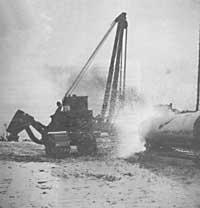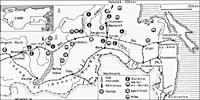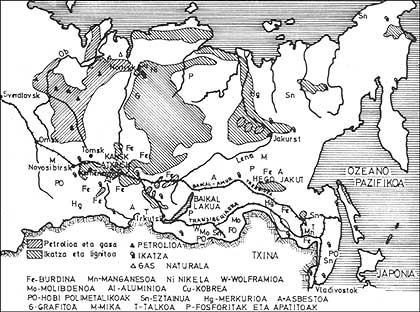The second Trans-Siberian railway
1986/06/01 Azkune Mendia, Iñaki - Elhuyar Fundazioa | Etxeberria, Isabel Iturria: Elhuyar aldizkaria
The first part of the long new Soviet Union railway has recently been inaugurated. Railway 3,000 km. On sustainable ice you will cross Eastern Siberia. It is one of the richest territories in the world. They have found huge amounts of minerals and fuels.
Thus, the Soviet Union wants to bring civilization to the icy regions of Eastern Siberia after two million years of time. Archaeologists have announced that the Stone Age civilization existed in the remote taigas of Yagur two million years ago. The Yakut area is one of the coldest regions in the world, with winter temperatures of -40°C and pavement always frozen to a depth of 1,500 meters.
Great resources
But the Soviets are carrying out a project to conquer the rich taiga of Yakut. Not only archaeologists, but also geologists have made valuable discoveries. It is estimated that there are 88 billion tons of coal and 7.7 million tons of iron, approximately 10% of the world's known resources. In the north of the new railroad there are huge piles of gas and above gold and diamonds.
They call it BAL of the new railroad: Linea Baikal-Amur) The first section focuses on the municipality of Nagorny. There, in an immense open-pit mine, every year 13 million tons of coal leave. Iron ore is also abundant in the area and a treatment plant of 9 million tons has been built every year. A thermal force will supply energy to metallurgical companies.
In summer there is a lot of copper around. Undoubtedly, the richest mines in the Soviet Union. But not only that: there is a lot of titanium, iron and other metals. But there is no shortage of coal so necessary to work these metals. Tin, zinc, copper, lead, wolfram, bismuth and molybdenum have been found in the Kholdomi valley. The hydroelectric power of the rivers that flow into Lake Baikal will be used to make these metals. In the Angara River and in Ust-Ilmsky they have built their houses of force.
At the end of the new railway, at the eastern end, there is abundant coal and the chemical industry develops, especially the woodworking industry.
The authors of the BAL project claim that there are still many minerals to discover these aspects. In the Priokhoyte area they think there is iron, phosphorite and non-ferrous metals. But above all the wood is there. The Soviet Union has the most wood in the world and estimates that there are 4 billion cubic meters of wood in the territory occupied by the BAL railway. However, these aspects are the coldest in the world and trees find it hard to grow. Therefore, they should be very careful when exploiting taiga.

Thus, Eastern Siberia will supply the Soviet industry with economic and abundant raw materials. But also to the Eastern capitalist industry.
The current Transiberian, moreover, is a bit obsolete and too full. On the other hand, it goes far from the mineral zones, near the Chinese border, and in case of war the insecurity of the current railway is evident.
For Kremlin managers, the BAL project is more important than the heaps of oil and gas in Western Siberia. From these western establishments derives capitalist Europe, the gas pipeline so hated by the Lehendakari Reagan.
Once the main line of the new railway is finished, the second investment period for the taiga will begin. Do not forget the branches that will put this new railway and the electrification projects that will have.
The Soviets, in this planning of the BAL, have occupied 1.5 million square kilometers (seven with Britain) and there are already a million people working in these territories.
Main project barriers
The Soviet Academy of Sciences has worked since its inception on the BAL project. In those terrible territories they have tried to overcome the barriers of housing in engineering. The new railway runs through seven mountain ranges. To do this, nine long tunnels have been cut into permanent ice and 126 large bridges have been built over the rivers that freeze in winter and overflow in spring. Already 700 million cubic meters of land have been transported in those aspects with temperatures between -40 ° C and +40 ° C.
Two have been the main headaches found during the project's execution: durable ice and earthquakes. Earthquakes occur in almost all of eastern Siberia: every hundred years. And small shakes can also damage lasting ice, putting it inside and softening it. In the 1960s, the foundations of the Olekma River Bridge suffered three major earthquakes (9 on the Richter scale). In each of the earthquakes holes were formed four meters wide and breakdowns of 5 km were found. According to seismologists, stones of 100 tons were taken.
Another obstacle for BAL students is the lack of land statistics. Therefore, they have needed new systems to locate the epicenter of the great earthquakes that occurred before. Based on the deformations of the soil structure, they were able to complete the earthquake map. This has allowed avoiding the most dangerous points in railway design.
However, the difficulties of this BAL are greater than in the First Trans-Siberian Railroad of the TSAR era. Permanent frosts are a deep whole. Rocks located 1,500 meters around the yakut are always frosted and, if it seems a lie, engineers have very wet lasting ice, provided they do not melt.
The use of large amounts of land in railroad construction causes the melting of ice and the formation of deep wells. Hence the railway runs on an ice slope and, in order to protect the ice (to reflect the rays of the sun), have covered the slopes with stones.

Cold and heat are also hard enemies for bridges. Eastern Siberia is full of rivers that, after melting ice during the spring, are flooded. Bridges, therefore, have had to be laid on solid and deep foundations.
However, one of the most difficult works has been the cut of the tunnel under the Kodar Mountains and between Severo-Musik. The tunnel, 15 kilometers long, suffered an accident in 1979, due to the fall of workers from the western area to the bed of an old river. Sources of hot water were also found among the ice and were about to leave. However, they have taken up the work even though every hour of the tunnel has to evacuate 30,000 cubic meters of water. They say it is one of the most complicated jobs in the history of civil engineering and expect it to end in 1986. Meanwhile, the 53-kilometer railway is built for trains to circulate around the mountain.
Despite the obstacles, Siberian goods begin their way to the Eastern Pacific. There, in Vostochny, Soviet engineers are building their largest seaport. From there they will export wood, coal, metals and elaborate materials to Europe.

Gai honi buruzko eduki gehiago
Elhuyarrek garatutako teknologia






